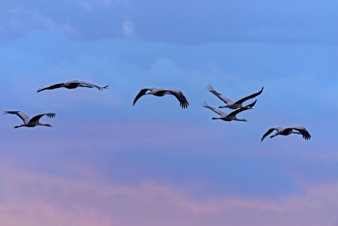21/03/2018 – editorial — auf Deutsch lesen
Spring has sprung!
At last – when the cranes return from far-off climes, we feel a sudden surge of excitement as we look forward to sunnier and warmer days when life seems just that little bit easier.
We also feel a sense of hope that things will get better – after all, the crane isn’t just a harbinger of spring and of light, but also a “bird of good fortune”. So, when these beautiful birds return, we get a sense that surely everything’s going to turn out just fine? But then my thoughts drift to another bird, the ostrich, and how it deals with difficulty. And then, I think of a friend of mine who recently said: "Sometimes, I can’t sleep at night and I’m literally close to tears because so many terrible things are happening in the world."
Indeed, the Heidelberg Conflict Barometer recently found that the number of wars across the world had climbed from 18 in 2016 to 20 in 2017. The study found that the Sub-Saharan states of Africa were being ravaged by ten wars and three "limited wars" and thus the largest number of violent conflicts in the world. The Heidelberg-based conflict researchers also identified war zones in the hot spots of Ethiopia, fuelled by differences between ethnic groups. Six wars and five "limited wars" are being waged in the Near and Middle East and north Africa. Three wars are listed for Syria alone: the war between the Assad regime and opposition fighters, the war between rival opposition groups and the war against the so-called "Islamic State" (IS). The most frequent causes of conflict are ideological – including religious – differences, ethnic differences as well as struggles for national power and resources, such as water (Source: DW/ Konfliktbarometer).
Resources are finite
After air, water is the most important elixir of life – everyone knows this, but do we act accordingly? We use plenty of water in the production of textiles (it’s common knowledge that 7,000 litres of water is used to produce one pair of jeans). Global textile output has doubled in just 16 years, from 2000 to 2016, exceeding 100 billion garments per year for the first time in 2014. This figure looks set to rise. Indeed, experts believe we will see a further increase of around 60% by 2030 (Source: Greenpeace). Besides Switzerland and the USA, Germany has among the highest consumption of apparel in the world, totalling 12 kg of clothing or an average of 60 new garments per head and year. Kirsten Brodde, textiles expert for Greenpeace, states: "We can’t keep on buying the same amount of clothes whilst believing we can save the planet." (GT, 1.3.2018, S. 27)
Whether and how clothing production and consumption can become more sustainable has been the subject of a large-scale project, funded by the German Federal Ministry of Education and Research. The findings of the "Slow Fashion" project are being revealed at a conference at the University of Hanover in March. For more information, please consult our online magazine. The project explored, among others, how consumers can be encouraged to shape their fashion consumption more sustainably. An undertaking that has proven extremely difficult! In this context, Brodde commented quite aptly: "We have to learn how to appreciate, look after and repair our clothing again," concluding, "We need to be patient with ourselves."




